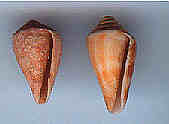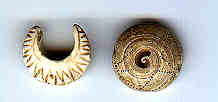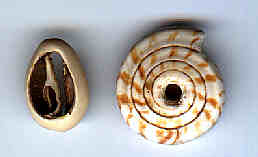Your path =Home>Beadmaking & Materials>Organic Materials> Beads and Seashells
Conus Shell Beads
The name for Conus shells is not nearly complex as for cowries.
Conus simply means "cone," and the shells are so named because they are shaped like two cones joined at the base.
|
The Conus animal is a carnivore that eats small fish and worms and drills into other shells to eat the animal inside. Some can give you a nasty sting if you pick up a live one.
Unlike most univalves, the Conus shell itself does not have a real columella. Instead of building a solid center spire, it produces a continual, thin, spiraled interior wall that is sometimes reabsorbed by the animal. It is easy to pierce a Conus shell by grinding off the apex and pushing a needle though it, breaking the thin interior walls.
Conus shells are strung up whole, but by far the most common way to use them is to smash off the whorl or body of the shell and use only the spire. This produces disc shaped beads, used since high antiquity.
|
Last Gallery PageNext Gallery Page
__________________________________________________
Small Bead Businesses | Beading & Beadwork | Ancient Beads | Trade Beads
Beadmaking & Materials | Bead Uses | Researching Beads | Beads and People
Center for Bead Research | Book Store | Free Store | Bead Bazaar
Shopping Mall | The Bead Auction | Galleries | People | Events
The Bead Site Home | Chat Line | Contact Us | Site Search Engine | FAQ


